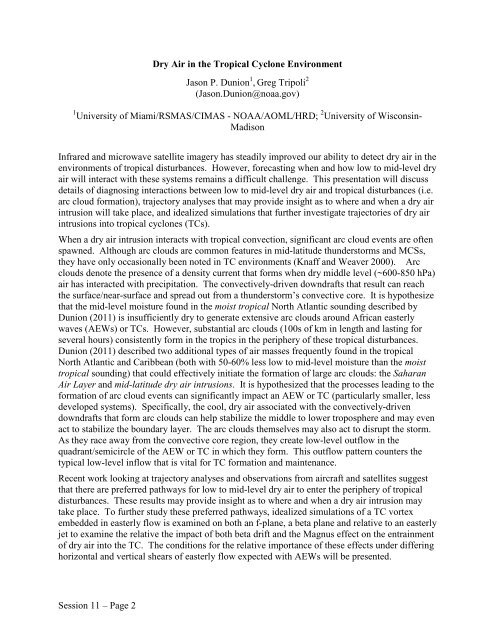65th IHC Booklet/Program (pdf - 4.9MB) - Office of the Federal ...
65th IHC Booklet/Program (pdf - 4.9MB) - Office of the Federal ...
65th IHC Booklet/Program (pdf - 4.9MB) - Office of the Federal ...
Create successful ePaper yourself
Turn your PDF publications into a flip-book with our unique Google optimized e-Paper software.
Dry Air in <strong>the</strong> Tropical Cyclone Environment<br />
Jason P. Dunion 1 , Greg Tripoli 2<br />
(Jason.Dunion@noaa.gov)<br />
1 University <strong>of</strong> Miami/RSMAS/CIMAS - NOAA/AOML/HRD; 2 University <strong>of</strong> Wisconsin-<br />
Madison<br />
Infrared and microwave satellite imagery has steadily improved our ability to detect dry air in <strong>the</strong><br />
environments <strong>of</strong> tropical disturbances. However, forecasting when and how low to mid-level dry<br />
air will interact with <strong>the</strong>se systems remains a difficult challenge. This presentation will discuss<br />
details <strong>of</strong> diagnosing interactions between low to mid-level dry air and tropical disturbances (i.e.<br />
arc cloud formation), trajectory analyses that may provide insight as to where and when a dry air<br />
intrusion will take place, and idealized simulations that fur<strong>the</strong>r investigate trajectories <strong>of</strong> dry air<br />
intrusions into tropical cyclones (TCs).<br />
When a dry air intrusion interacts with tropical convection, significant arc cloud events are <strong>of</strong>ten<br />
spawned. Although arc clouds are common features in mid-latitude thunderstorms and MCSs,<br />
<strong>the</strong>y have only occasionally been noted in TC environments (Knaff and Weaver 2000). Arc<br />
clouds denote <strong>the</strong> presence <strong>of</strong> a density current that forms when dry middle level (~600-850 hPa)<br />
air has interacted with precipitation. The convectively-driven downdrafts that result can reach<br />
<strong>the</strong> surface/near-surface and spread out from a thunderstorm’s convective core. It is hypo<strong>the</strong>size<br />
that <strong>the</strong> mid-level moisture found in <strong>the</strong> moist tropical North Atlantic sounding described by<br />
Dunion (2011) is insufficiently dry to generate extensive arc clouds around African easterly<br />
waves (AEWs) or TCs. However, substantial arc clouds (100s <strong>of</strong> km in length and lasting for<br />
several hours) consistently form in <strong>the</strong> tropics in <strong>the</strong> periphery <strong>of</strong> <strong>the</strong>se tropical disturbances.<br />
Dunion (2011) described two additional types <strong>of</strong> air masses frequently found in <strong>the</strong> tropical<br />
North Atlantic and Caribbean (both with 50-60% less low to mid-level moisture than <strong>the</strong> moist<br />
tropical sounding) that could effectively initiate <strong>the</strong> formation <strong>of</strong> large arc clouds: <strong>the</strong> Saharan<br />
Air Layer and mid-latitude dry air intrusions. It is hypo<strong>the</strong>sized that <strong>the</strong> processes leading to <strong>the</strong><br />
formation <strong>of</strong> arc cloud events can significantly impact an AEW or TC (particularly smaller, less<br />
developed systems). Specifically, <strong>the</strong> cool, dry air associated with <strong>the</strong> convectively-driven<br />
downdrafts that form arc clouds can help stabilize <strong>the</strong> middle to lower troposphere and may even<br />
act to stabilize <strong>the</strong> boundary layer. The arc clouds <strong>the</strong>mselves may also act to disrupt <strong>the</strong> storm.<br />
As <strong>the</strong>y race away from <strong>the</strong> convective core region, <strong>the</strong>y create low-level outflow in <strong>the</strong><br />
quadrant/semicircle <strong>of</strong> <strong>the</strong> AEW or TC in which <strong>the</strong>y form. This outflow pattern counters <strong>the</strong><br />
typical low-level inflow that is vital for TC formation and maintenance.<br />
Recent work looking at trajectory analyses and observations from aircraft and satellites suggest<br />
that <strong>the</strong>re are preferred pathways for low to mid-level dry air to enter <strong>the</strong> periphery <strong>of</strong> tropical<br />
disturbances. These results may provide insight as to where and when a dry air intrusion may<br />
take place. To fur<strong>the</strong>r study <strong>the</strong>se preferred pathways, idealized simulations <strong>of</strong> a TC vortex<br />
embedded in easterly flow is examined on both an f-plane, a beta plane and relative to an easterly<br />
jet to examine <strong>the</strong> relative <strong>the</strong> impact <strong>of</strong> both beta drift and <strong>the</strong> Magnus effect on <strong>the</strong> entrainment<br />
<strong>of</strong> dry air into <strong>the</strong> TC. The conditions for <strong>the</strong> relative importance <strong>of</strong> <strong>the</strong>se effects under differing<br />
horizontal and vertical shears <strong>of</strong> easterly flow expected with AEWs will be presented.<br />
Session 11 – Page 2
















